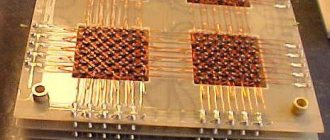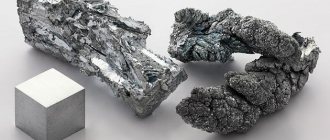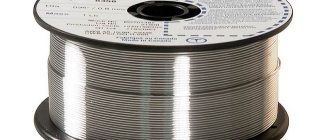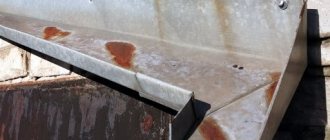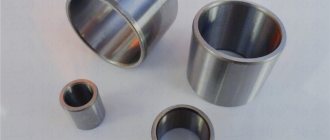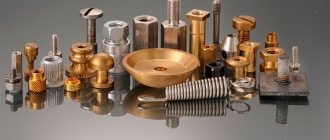Properties of aluminum bronzes
Aluminum bronzes are copper-based alloys in which the main alloying metal is aluminum. The material has increased strength properties, is resistant to corrosion and has a low coefficient of friction. The aluminum content in such alloys reaches 11%-12%.
Mechanical properties of aluminum bronzes
Depending on the aluminum content, the finished materials have different mechanical properties:
- When the proportion of aluminum in the alloy increases to 10-11%, the mechanical strength of the material increases noticeably up to 600 MPa.
- If the proportion of alloying additive continues to increase, the strength properties of aluminum bronzes noticeably decrease.
- Single-phase bronzes have a high ductility index, and two-phase bronzes have a high hardness index.
The highest quality bronze with the addition of aluminum, the physical properties and strength characteristics of which ensure its widespread use in industry, is the high-alloy BrA7 alloy.
Physical properties of aluminum bronzes
The physical properties of aluminum, which is part of the alloy, provide the finished material with the following characteristics:
- The more aluminum there is in an alloy, the lower its density and, accordingly, its mass. This property of aluminum alloy significantly expands the scope of its application, especially in aircraft construction and space technology.
- When polished, the surface of aluminum bronze has a high reflective ability.
- Increasing the percentage of aluminum in the alloy reduces the thermal conductivity of the material. If additional alloying additives are added to the composition - nickel, iron or manganese, then the thermal conductivity decreases even more.
- With an increased aluminum content, such properties as the electrical conductivity of the metal change. This is achieved by reducing the percentage of copper, which better conducts electric current. When manganese is introduced into the composition of the material, the alloy will have the highest electrical resistance.
The anti-corrosion properties of aluminum make it possible to obtain two-component deformable bronze marked BrA5, which is widely used in the manufacture of parts for marine vessels due to the metal’s resistance to aggressive aquatic environments.
Changes in the properties of aluminum bronzes with the introduction of additional alloying additives
To improve the properties of aluminum and its alloys, additional alloying additives are introduced into the composition of the finished material:
- With the introduction of iron, a sharp increase in strength is observed to the detriment of the ductility of the material and a decrease in its impact strength.
- With the introduction of manganese in an amount of 3% to 4%, the basic anti-corrosion properties of aluminum are significantly increased. In addition, the strength characteristics and ductility of the alloy increase.
- Nickel is considered the optimal alloying additive, which improves all the quality characteristics of the alloy. By adding this element, the heat resistance of the material increases, the coefficient of friction decreases, and ductility increases. At extremely low temperatures, the crystal lattice does not become brittle.
In recent years, scientists have begun to produce multi-component aluminum bronzes. Nickel and iron are mixed into the standard alloy at the same time in certain proportions, which increases all the quality characteristics of the finished product.
Compositions
Aluminum bronze 5 franc coins 1940 Aluminum bronze with 20% aluminum at 500x magnification
The following table lists the most common standard compositions of aluminum bronze wrought alloys according to the ISO 428 designation. Percentages indicate the proportional weight of the alloy. The rest of copper is not specified:
| Alloy | Aluminum | Iron | Nickel | Manganese | Zinc | Arsenic |
| CuAl5 | 4.0–6.5% | 0.5% max. | 0.8% max. | 0.5% max. | 0.5% max. | 0.4% max. |
| CuAl8 | 7.0–9.0% | 0.5% max. | 0.8% max. | 0.5% max. | 0.5% max. | |
| CuAl8Fe3 | 6.5–8.5% | 1.5–3.5% | 1.0% max. | 0.8% max. | 0.5% max. | |
| CuAl9Mn2 | 8.0–10.0% | 1.5% max. | 0.8% max. | 1.5–3.0% | 0.5% max. | |
| CuAl10Fe3 | 8.5–11.0% | 2.0–4.0% | 1.0% max. | 2.0% max. | 0.5% max. | |
| CuAl10Fe5Ni5 | 8.5–11.5% | 2.0–6.0% | 4.0–6.0% | 2.0% max. | 0.5% max. |
external reference
| Wikimedia Commons has media related to Aluminum bronze . |
- Copper Development Association. "Publication No. 80: Guide to Corrosion Resistance of Aluminum Bronze Alloys", PDF. Retrieved April 9, 2014.
- Copper Development Association. "Publication No. 82: Technical characteristics of aluminum-bronze alloys." Retrieved April 9, 2014.
| Authoritative control |
|
Applications
Aluminum bronze is most often used in applications where their resistance to corrosion makes them preferable to other engineering materials. These applications include journal bearings and landing gear components on aircraft, guitar strings, valve components, engine components (especially for marine vessels), underwater mounts in naval architecture, and ship propellers.[2] Aluminum bronze is also used to comply with the ATEX Directive for zones 1, 2, 21 and 22. The attractive golden color of aluminum bronzes has also led to their use in jewelry.
Aluminum bronze is in greatest demand in the following industries and areas:
- General services related to sea water
- Water supply
- Oil and petrochemical industries ( i.e.
tools for use in non-sparking environments) - Specialized anti-corrosion applications
- Some structural modifications of buildings
Aluminum bronze can be welded using the MIG welding technique with an aluminum bronze core and pure argon gas.
Aluminum bronze replaces gold when casting dental crowns. The alloys used are chemically inert and have the appearance of gold.
Coins use alloys similar to aluminum bronze, such as the 20, 200 and 500 Italian Lira coins, the 10 Philippine Peso coins on the inner ring, the one and two dollar coins Australian and New Zealand currency produced by the Royal Australian Mint, some Mexican coins and Nordic gold are used for some euro coins. The Canadian $2 coin, produced by the Royal Canadian Mint and distributed since 1996, is a bimetallic piece with an outer ring of nickel-plated steel and an inner ring of aluminum bronze consisting of 92% copper, 6% aluminum and 2% nickel (also known as as bronzital).
Use of metal in construction
Bronze is a good construction material, although it is not used in construction exactly in this capacity: it is too expensive. However, it finds its application in those parts and objects where its corrosion resistance and durability are indispensable.
Plumbing
An alloy used in this form is a sign of luxury and wealth. From both a utilitarian and a decorative point of view, bronze is certainly good in this area, but such items also have an impressive cost.
- Hygiene - alloys do not have pores, which means they do not accumulate dirt and do not allow bacteria to multiply. And for a washbasin or toilet this is a very valuable quality.
- Corrosion resistance - bronze is not affected by hot or cold water, dampness, or household chemicals. Bathrooms and washbasins can be subjected to any disinfection procedures.
- Thermal conductivity - as a rule, the low thermal and electrical conductivity of a metal alloy is a disadvantage, but not in this case. Bronze conducts heat much worse than copper, and therefore retains it longer. This is a great quality for a bathroom.
- Durability - a bronze object “abandoned” to the mercy of fate eventually becomes covered with a patina, which prevents further corrosion of the alloy. So bronze plumbing is the choice for many decades.
- Decorative – different bronze alloys have different shades, usually yellow and red. The color is very rich, includes a lot of shades, and the slightest relief only emphasizes this play of color. Polished bronze shines like gold.
In addition, good malleability allows you to make small parts - taps, bathtub legs, handles in the form of sculptural images, and such decoration will turn any bathroom into a royal one.
No less popular are plumbing fixtures and fittings “bronze-like”, coated with a thin layer of alloy. Its user characteristics are lower, but the decorative effect is quite decent.
Fitting
If it were not for the cost, all possible components and wiring in hot and cold water supply systems would be made from bronze. In practice, both bronze and brass are used only in the most critical areas. Moreover, they are equally practical for heating systems and for drinking water supply.
But bronze fittings of the most varied types, both threaded and for capillary soldering, are used very widely.
- Bronze parts are especially effective when it is necessary to assemble pipes from different materials into one system. Bronze is capable of creating a cathode layer on the inside of the protection pipe, thereby preventing the occurrence of electrochemical corrosion.
- Bronze fittings are characterized by extreme mechanical strength.
- They are very resistant to temperature and pressure changes.
- Indifferent to the effects of chlorine and ozone dissolved in water.
- They suppress the activity of bacteria, which is very valuable when supplying drinking water.
Read below about the production of monuments, sculptures, busts, figurines, memorial plaques and other bronze figures.
Sculptures and monuments
Bronze is one of the hardest sculptural materials and the most durable. Bronze is not inferior to stone in strength and reliability, and in some ways even superior, since it is less sensitive to temperature changes. In addition, the material has excellent corrosion resistance and exhibits minimal shrinkage, which makes it possible to reproduce the most complex images in metal.
The alloy is used to make both the largest monuments and tiny figurines used to decorate a room. This is due to the technique of making statues - casting.
- Initially, the preparation for the sculpture is molded from wax. This material is very plastic at normal temperatures and allows you to reproduce the most microscopic relief, right down to skin roughness invisible to the eye. Then a layer of clay is applied to the workpiece and wax is melted, thus obtaining a ready-made mold for casting. Well, then comes the turn of bronze.
- To increase the effect, the finished sculpture can be polished, increasing the shine and play of shades.
Commemorative plaques, emblems, bas-reliefs, coats of arms, and so on are also made from bronze. This is a favorite material for garden architecture: fountains, details of benches, gazebos, rotundas, garden sculptures, etc., made of bronze are always beautiful.
Read below about making stencils and other bronze products as household items.
Unique bronze sculptures are presented in this video:
Houseware
Few things go as well with classic interiors as bronze. Matte or shiny, patinated or gilded, it is equally impressive, noble and sophisticated. Even in the most fashionable urban interior - hi-tech, loft, techno, there is a place for it.
- Accessories - overhead hinges, decorative locks, handles of the most incredible shapes. Bronze fittings are beautiful and practical, since this beauty will definitely not be damaged by dampness, spilled coffee, or the inquisitive interest of a child.
- Bathroom fittings - towel holders, taps, shower heads, screen rods and much more. If it is not possible to install a bronze bathtub on lion legs, bronze faucets will add elegance to the room.
- Decorative items - ashtrays, candy dishes, coasters of any kind and kind, floor lamps and, of course, candlesticks - an indispensable accessory for a romantic evening - can be made from bronze. Bronze, with its rich color and texture, emphasizes the individuality of the interior like no other material.
The use of bronze is also required in the manufacture of larger objects - a picture frame, a fireplace grate, a floor hanger, a footstool and other optional but exquisite items that make up the real decoration of the room.
- Bronze utensils are now used much less frequently. However, a bronze cup, dish or vase can still become the highlight of a festive table.
- Bronze jewelry today is a sign of very unconventional taste. They are rarely seen in everyday life, which is a pity: their beauty and grace are quite comparable to jewelry.
- Making souvenirs from aluminum, brass and bronze is also popular.
Bronze is a whole group of diverse and mostly very beautiful alloys. Therefore, their use is determined not only by the technical characteristics, but also by the attractiveness of the alloy.
The video below will tell you about the use of architectural bronze:
